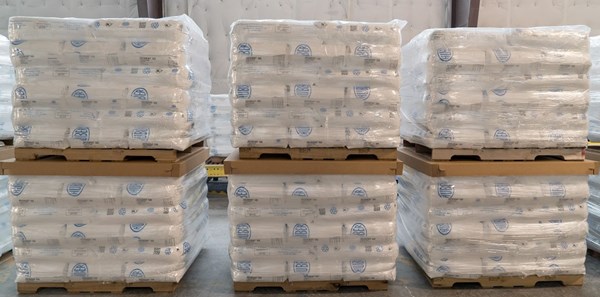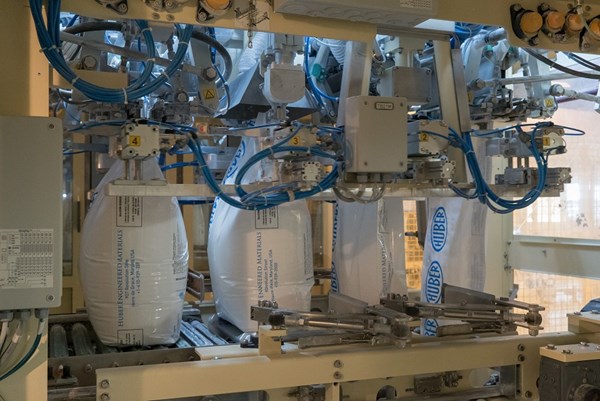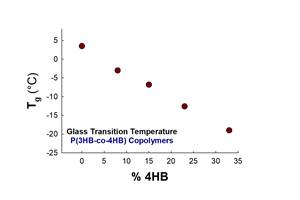LLDPE Replaces Paper In Additive Packaging
The new packaging system replaces paper bags with more robust LLDPE bags.

The new packaging system replaces paper bags with more robust LLDPE bags.
Among the many times through the years that I have reported on plastic chemicals and additives news, I’d say it’s been less than a handful of times where the topic was about their packaging. Typically, it’s about new and/or improved versions of additives that improve performance of plastics and/or their physical form (e.g., pellets, beads) which allow for easier handling. Some small particle additives, in particular, have traditionally posed particular challenges.
So, I found it interesting to hear that J.M. Huber Corp.’s Huber Engineered Materials division had invested in an innovative, multi-million dollar packaging system, which replaces paper bags with a conversion to more robust LLDPE bags at its precipitated amorphous silica Havre de Grace, Md., production facility. Huber’s silicas and silicates are used in a variety of industries and when targeted as an anti-blocking agent for plastics, polyolefins is a key application.
A Huber spokesman explained that the new filling technology and use of LLDPE bags for small particle materials such as silicon dioxide is just emerging. “Use of plastic bags is more and more common for gardening items and masonry materials….those industries have been converting for many years but are much easier to package than silica because of the large particle sizes and high bulk density. The expertise in the design of the packaging equipment, coupled with the emerging technology in the design of the films used to create the LLDPE bags effectively adapts to handling silica’s unique properties,” he says.
Asked if the LLDPE choice is unusual for packaging these type of additives, the Huber source notes that PP is most commonly used in both Asia, where sacks are reused for other purposes, and India, due to lack of trees/paper. He notes, however, that these PP bags release considerably more dust and are manually filled. Here’s more on Huber’s system and bags:
• Huber’s new packaging platform is being introduced systematically across the globe with automatic filling equipment already in place in select production facilities in the European and American regions, with the intention to do the same in Asia in 2017. (The company is a global leader in precipitated silica with seven manufacturing sites strategically located across North America, Europe, and Asia.)
• The improved LLDPE bags offer stronger tensile strength.
• The LLDPE bags minimize the nuisance of dust.
• They eliminate trapped air within each LLDPE bags, making the packages more easily stackable for more stable pallets during shipment, unloading, and warehousing.
• The LLDPE bags also provide increased printing and labeling options.
• The new packaging is also easily recyclable which is integral to Huber’s commitment to sustainability.
According to the Huber spokesman, the novel packaging’s development was also influenced by customers’ requests for improved performance over paper bags—which are susceptible to moisture, excessive dusting, improved recycling needs, emerging food safety, and employee health exposure regulations.
For more on Huber and additives offered, see PT’s additives database.

Related Content
Film Extrusion: Boost Mechanical Properties and Rate of Composting by Blending Amorphous PHA into PLA
A unique amorphous PHA has been shown to enhance the mechanical performance and accelerate the biodegradation of other compostable polymers PLA in blown film.
Read MoreWhat You Need to Know About Roll-Cooling Design
Cooling rolls might not look like high-tech machines, but the fact is there is a surprising amount of technology involved in their design, manufacture and use. Here’s what you need to know.
Read MoreMasterbatch Creates Cavities, Helping Film Processors Boost Sustainability, Recyclability
Additive technology creates air pockets in film during orientation, cutting down on the amount of resin needed while boosting opacity, mechanical properties and recyclability.
Read MoreDeflection Elbows Eliminate Streamers for Large Film Processor
New elbows eliminate troublesome streamers to increase productivity at leading blown film processor.
Read MoreRead Next
People 4.0 – How to Get Buy-In from Your Staff for Industry 4.0 Systems
Implementing a production monitoring system as the foundation of a ‘smart factory’ is about integrating people with new technology as much as it is about integrating machines and computers. Here are tips from a company that has gone through the process.
Read MoreSee Recyclers Close the Loop on Trade Show Production Scrap at NPE2024
A collaboration between show organizer PLASTICS, recycler CPR and size reduction experts WEIMA and Conair recovered and recycled all production scrap at NPE2024.
Read More












